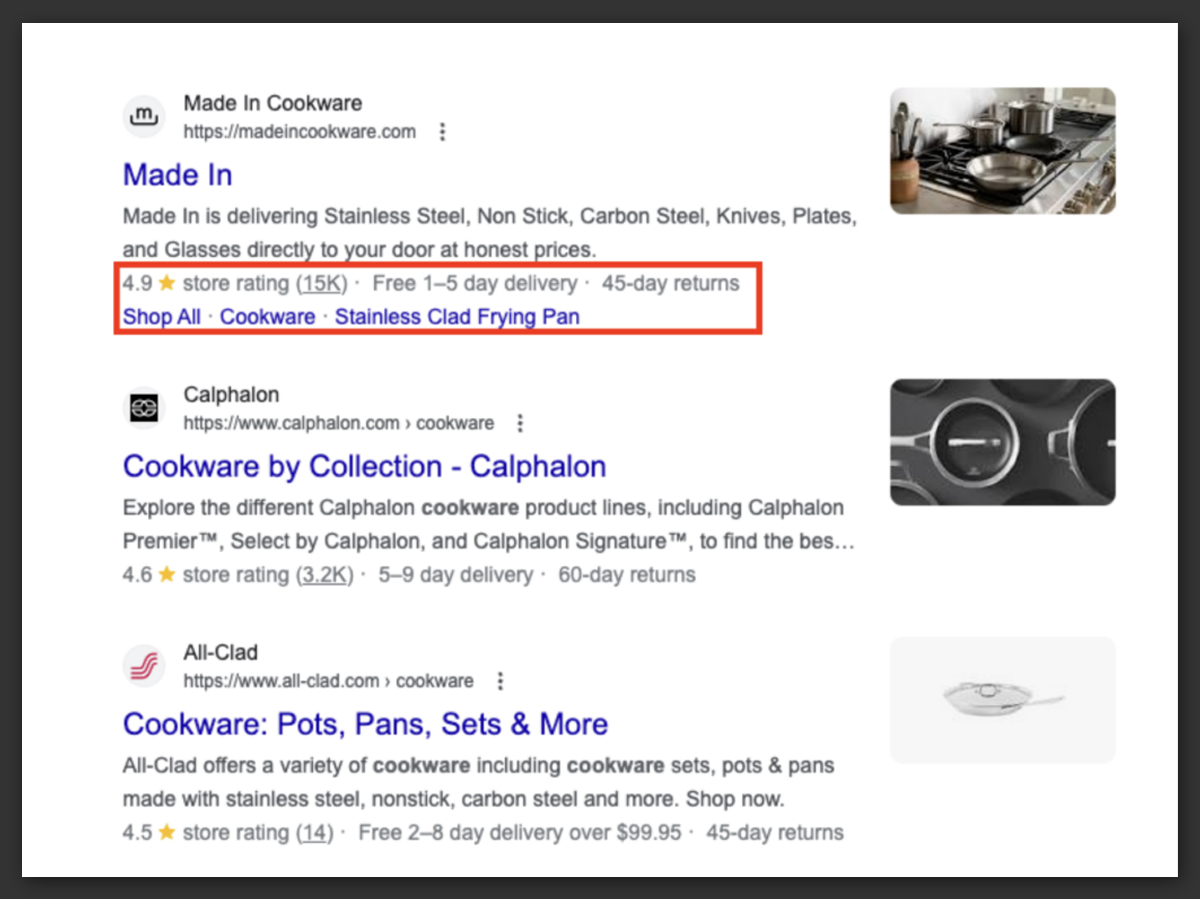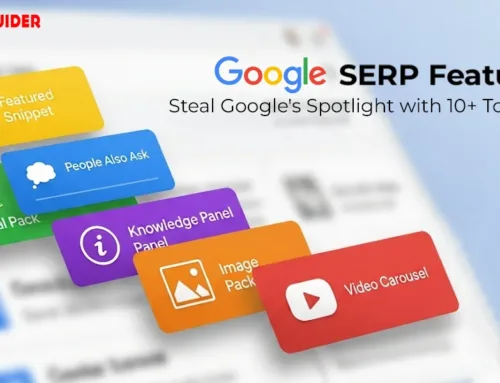Do you want to drive more organic search traffic to your website and improve your search rankings?
Imagine transforming your website from a hidden gem into a top-ranking treasure trove of valuable content. However, search engines constantly evolve their algorithms, impacting your traffic, performance, and where you land in the SERPs.
Well, it might be impossible to accurately predict how these algorithm changes will impact your traffic and rankings, but you’ll still need to deliver on client expectations.
To do that, you need to know some modern SEO terms & apply proven techniques that help you keep up with the changes. Here are 11 suggestions for the strategy you should be using to make the best of the resources at your disposal and prevent losing rankings and traffic to your competitors.
Ready to take your website to the next level? Let’s dive into the SEO tactics that can transform your online presence.
11 Proven SEO Strategies for Driving Website Traffic
1. Give users what they want
The motivation behind every search query on search engines is the intent and context. Search intent refers to the reason behind a user’s search query. It can be informational, navigational, transactional, or commercial. Understanding and aligning with this intent is crucial for SEO success.
Understanding that the search results that searchers select to engage with are invariably the ones that meet their search intent empowers you to create effective content. You’re in control of your website’s destiny.
To increase the likelihood of your content being chosen by searchers in search results, it must fulfil their needs by:
- Demonstrating how to address a problem they’re facing
- Offering the information they seek
- Providing solutions to their inquiries
To ensure that your content meets user expectations, ensure that your keyword strategy, which involves researching and selecting the right keywords to target in your content, is in line with the search intent.
Begin by identifying key phrases that are relevant and have lower competition, and then develop content that directly addresses the questions of your audience.
For instance, a person searching for an RV rental may have particular questions regarding the various types of RV rentals available.
Rather than focusing solely on “RV rentals,” Cruise America takes a more specific approach by targeting the broader keyword “long-term RV rentals.”
This strategy not only addresses the questions that searchers have about RV rentals but also positions your content highly in search engine results pages:

2. Optimize for algorithms
Search engines continuously evolve, and so do their algorithms. To stay ahead, it’s crucial to optimize your website based on current search engine algorithm updates. Here’s how:
For example, When Google introduced the Core Web Vitals update, they placed a huge emphasis on user experience metrics like page speed, mobile responsiveness, and visual stability. Websites that adapted to these changes saw a significant boost in rankings.
Sites that were slow to load or had a poor mobile experience began losing ranking positions.
Improving your website speed by compressing images, utilizing browser caching, and reducing server response time helped many websites adapt. For example, websites like The Verge optimized their layout and reduced load time by 2 seconds, gaining higher rankings.
Google’s focus on Experience, Expertise, Authoritativeness, and Trustworthiness (E-E-A-T) changed how content was evaluated. Content from trusted sources has become more valuable than ever.
Medical, legal, and financial websites needed authoritative sources and expert content to rank. Websites like Healthline leveraged expert authors and sourced information from credible studies to build trust, which led to a 20% increase in organic traffic post-update.
Always stay up-to-date with search engine algorithm changes and adjust your Search Engine Optimization strategy accordingly. This knowledge will keep you ahead of the curve and maintain your competitive edge.
3. Maximize your SERP exposure
When searchers type their queries into search engines, they’re more likely to click on prominent search results. This is because search engines carefully select these results to provide the most relevant information to the searchers.
You’ll need to improve your visibility in search results to maximize your SERP exposure.
How? By implementing schema markups, which are a form of microdata that provide additional context to your content, and structured data, which organizes your content in a way that search engines can understand, to give search engines more information about your content.
Schema markups allow you to highlight key information, such as:
- Customer reviews
- Product details
- Ratings
- Events
4. Show web crawlers exactly where to go
When searchers type their queries into search engines, they’re more likely to click on the top results that appear on the first page.
These results, often referred to as ‘prominent search results ‘, are carefully selected by web crawling and indexing to help Google organize content and make it available to searchers.
If your website isn’t appearing in search results, it could be because Google hasn’t crawled it yet. A few reasons for this could include:
- Poor site navigation that prevents robots from crawling effectively
- You’ve got directives that block search engine crawlers
Fix this by using a robots.txt file, a tool that instructs crawlers on which pages to crawl and which to ignore, thereby improving the efficiency of the crawling process.

After that, create an XML sitemap, a file that lists all the pages on your site, to help crawlers find and index your site’s pages efficiently. This will enable search engines to provide the most relevant information to the searchers.

5. Find “Suggest” Keywords
An often overlooked but highly effective SEO strategy is using “suggest” keywords. These are the terms that search engines auto-populate when users begin typing in the search bar. They provide valuable insights into what people are actively searching for.
For instance, when you type “best wedding venues” into Google, the search engine will automatically suggest locations like “Oregon,” “Florida,” or “Mexico,” depending on your previous searches or local trends.
These auto-suggestions highlight high-demand searches that can be strategically targeted in your content.
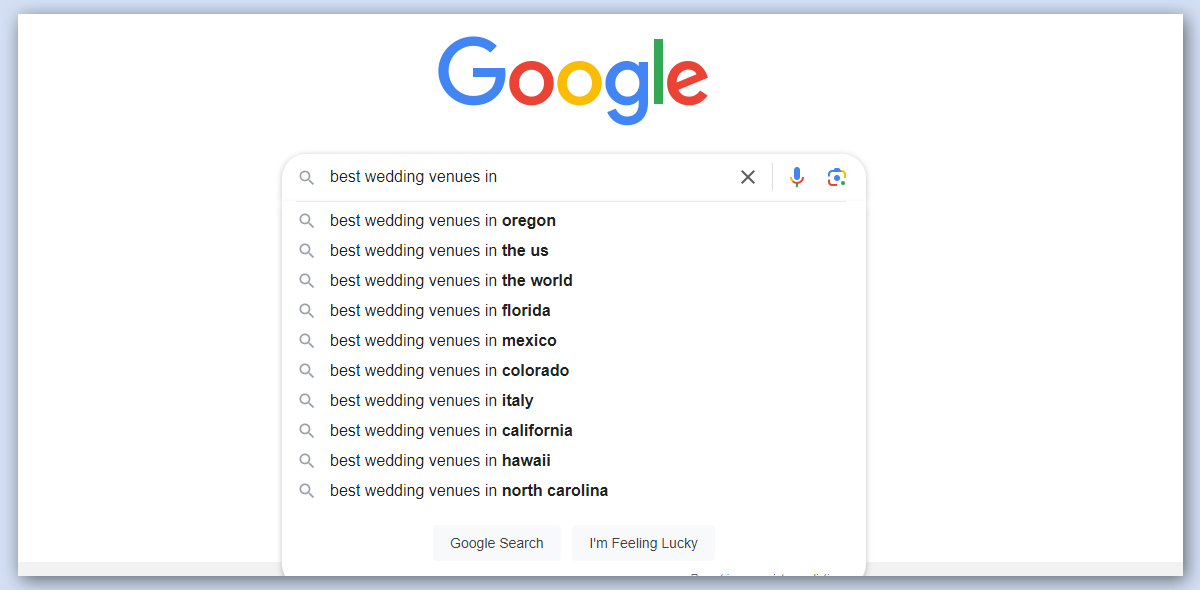
There are some tools, such as Ubersuggest or Google Keyword Planner, that can help you further analyze the search volume and competition of these “suggest” keywords. By targeting these, you’ll increase your chances of ranking for queries that potential customers are typing into search engines.
6. Focus on “Top of the Funnel” Keyword Phrases
The primary stages of the keywords funnel include awareness, evaluation, and choice.
When discussing the initial stage of the funnel, I refer to the key phrases that capture the interest of potential customers and direct them to your site.
In fact, 95 percent of marketers ensure they create content for their brand that targets top-of-funnel keywords.
Content aimed at these terms helps to “create awareness” about the subject. It engages the audience without requiring them to make a decision immediately. This is the purpose of the subsequent stages of the funnel.
What do these keywords look like? Top-of-the-funnel keywords tend to answer more general questions about the topic. There are many different examples of what they look like, but here is one you can refer to:

By focusing on these keywords, you’re doing two things:
- Reaching a larger audience as these terms tend to have higher search volumes
- Drawing in users earlier in their research process
Optimizing your content for social sharing is not just a smart move; it’s a game-changer. It ramps up your content’s visibility and engagement on social media while also giving your SEO efforts a powerful push.
For example, when the content you publish receives massive engagement on social media, it can:
- Increase the likelihood of getting backlinks from reputable websites
- Drive traffic to your website
- Boost brand awareness
Optimizing content for social sharing starts with carefully selecting topics that resonate with your target audience and drive conversations within your niche.
Thought leadership content easily captures the attention and emotions of your target audience, and it could either be:
- A personal story
- A controversial take on something going on in your industry
- Pointing out a best practice that’s out of date and sharing a new way forward
When creating content, incorporate relevant visuals that’ll make it easier to distribute it on relevant social media channels.
You can create high-quality images, videos, or custom graphics. It makes it easier for social media users to understand it without having to leave the social media platform they’re on.
Optimizing your content for social sharing is more than just crafting great articles—it’s about strategically amplifying your message to the right audience.
Imagine you publish a thought-provoking blog post about an outdated practice in your industry and suggest a new, innovative approach. Now, this piece of content, coupled with eye-catching visuals, sparks conversations on Twitter, Facebook, or LinkedIn.
Not only does it increase social media engagement, but it also boosts traffic to your website as curious readers click through.
Moreover, the more your content is shared and discussed, the higher the chances are that authoritative websites will link back to your post, strengthening your SEO and expanding your brand’s reach.
To maximize the impact, ensure you’re delivering stories or perspectives that evoke emotion, challenge norms, or present fresh insights—these are the types of content that thrive in social spaces.
8. Focus on user experience (UX)
Page load times, accessibility, personalization, navigation, and content quality remain integral components of a great user experience.
However, the user experience goes beyond these elements.
The authentication process, a gateway to a secure and personalized user journey, is the foundation of trust.
And user trust, as the cornerstone of online success, is increasingly factored into search engine algorithms.
Standards like OIDC, for instance, can elevate the authentication process, ensuring high security and a seamless user experience.
As online security breaches make headlines, implementing OIDC safeguards user data and reinforces your website’s credibility. Search engines reward secure websites, making OIDC a powerful SEO booster.
Beyond security, the OIDC framework offers a versatile solution for crafting SEO-friendly user authentication experiences.
By simplifying the login process, you reduce friction and ensure a swift journey from arrival to conversion.
Websites prioritizing OIDC can significantly improve their bounce rates and dwell times . OIDC’s user-friendly login process and enhanced security can keep users on your site longer, which are metrics closely monitored by search engines.
9. Optimize for voice search
In 2024, making your content to be voice search-friendly isn’t merely a smart strategy — it’s crucial.
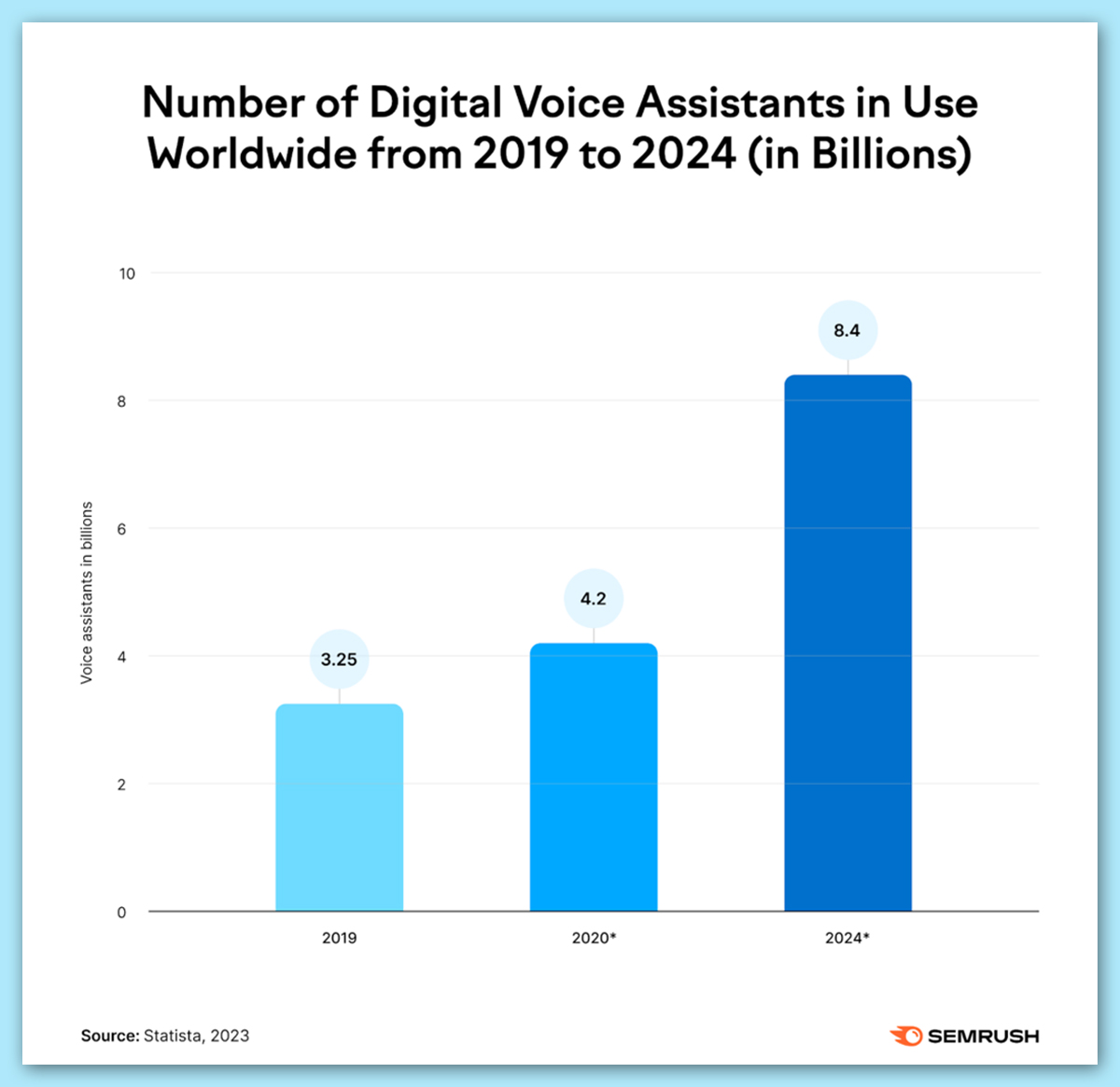
We rarely speak the way we type, so when searchers head over to a search engine, they often include shorter and more specific terms in their search.
Voice search, with its full sentences and NPL, demands a different approach to optimization. To effectively cater to this, incorporating longtail, conversational keywords becomes a necessity in your strategy.
That’s where a text-to-voice tool like LOVO can be a game-changer. It can streamline your content creation process by converting scripts or plain text content (such as social media videos or podcasts) into voiceovers. This not only saves time but also ensures that your content is optimized for voice search, enhancing its discoverability.
You can focus on the following to ensure your content is primed for voice search:
- Focus on conversational (longtail) keywords
- Improve website loading speed
- Optimize for local searches
- Create FAQ pages
Adapting to these strategies works overtime to boost your visibility in voice search results and also improve your overall SEO.
10. Build more relevant links
Remember, securing backlinks from reputable and high-authority websites is not just a strategy; it’s a key to boosting your site’s credibility, enhancing search engine rankings, and improving online visibility.
Diversifying your backlink profile by acquiring links from a range of authoritative sources helps in establishing a well-rounded and natural link profile. This means your backlinks are not only from high-authority sites but also from a variety of sources, which is a more natural and organic way of building your link profile.
Strategically engage in guest posting and collaboration with high-quality, relevant sites, including leading industry publications, to build a diverse portfolio that reflects your site’s credibility.
A well-balanced link profile is more resilient to search engine penalties and better equipped to handle changes in algorithm updates.
11. Prioritize low-difficulty topics to fast-track progress in search engines
If your website is just starting, focusing on easy-to-rank subjects is a good strategy. This is because you find it challenging to secure a high position for topics that are already popular.
A keyword research tool such as Ahrefs’ Keywords Explorer is a great option for locating these topics. Simply look for potential keywords, and then narrow down your search to those that have a low Keyword Difficulty (KD) rating.
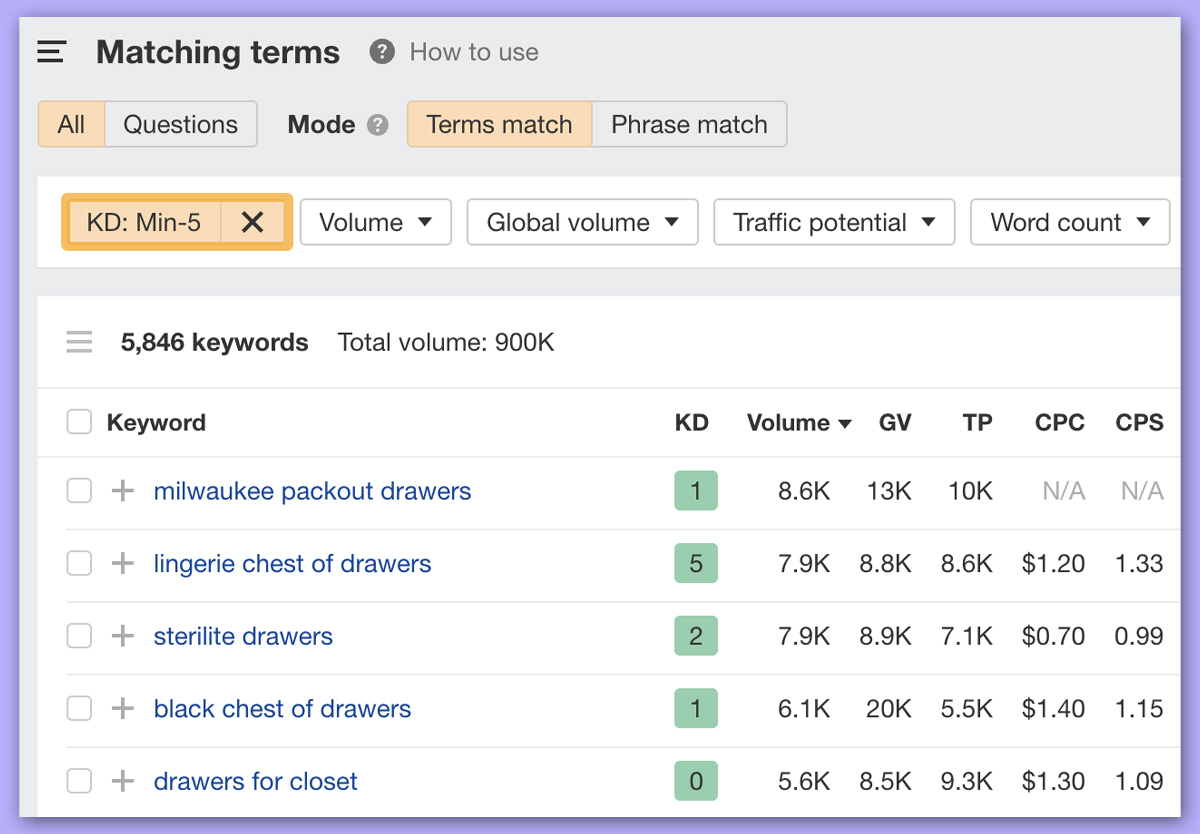
If you want to find keywords that are not just low KD but also possess a website ranking within a specific DR range in that keyword’s SERP, you can apply the “Lowest DR” filter.
In the example provided, I’ve specified a DR up to 10 that appears in the top five.
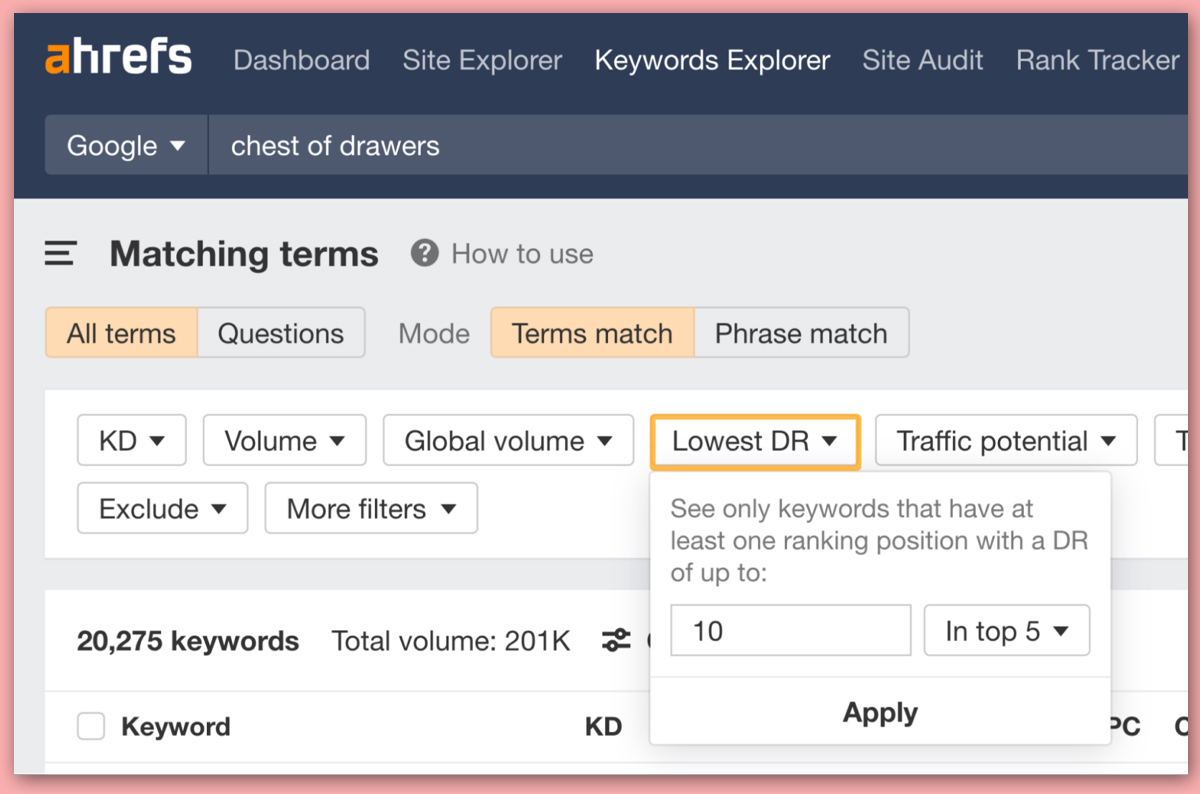
After we’ve set up the filter, we’re able to navigate through the relevant terms and move down to the SERP summary to view the outcomes.
Indeed, we can observe the fifth position with a DR 7 for the term “willowton chest of drawers.”

This is a powerful SEO technique to find low KD and “weak SERPs”—where a low-DR site is ranking among much higher DR sites.
Conclusion: Elevate Your SEO Game and Watch Your Traffic Soar
As we’ve explored these 11 game-changing SEO techniques, it’s clear that the landscape of search engine optimization is ever-evolving. From understanding user intent to optimizing for voice search, each strategy plays a crucial role in boosting your website’s visibility and driving organic traffic.
Remember, effective SEO isn’t about gaming the system—it’s about providing value to your audience while making your content easily discoverable. By implementing these techniques, you’re not just improving your search rankings; you’re enhancing the overall user experience and building a stronger online presence.
Ready to take your SEO strategy to the next level? Let us help you unlock the full potential of your website. Contact Digital Guider today to see how we can tailor these proven strategies to meet your unique business goals!
FAQs – SEO Techniques
1- How do I find the right keywords for my website?
Ans. You can use keyword research tools to identify relevant keywords that your target audience is searching for.
2- How can I optimize my website’s title tags and meta descriptions?
Ans. You can write compelling title tags and meta descriptions that include your target keywords and accurately describe your content.
3- How can I improve my website’s URL structure for better SEO?
Ans. You should use clear and descriptive URLs that include relevant keywords. Avoid long, complicated URLs.
4- How can I improve my website’s loading speed?
Ans. By Optimizing images, minifying CSS and JavaScript files, using a content delivery network (CDN), and leveraging browser caching.
5- How can I create an XML sitemap for my website?
Ans. An XML sitemap is a file that provides a list of all the important pages on your website. Submit it to search engines to help them crawl and index your content.
6- How social media SEO can help me?
Ans. It helps you improve your website’s search engine rankings and visibility by optimizing your social media presence.
7- How can I create high-quality content that attracts organic traffic?
Ans. Create informative, engaging, and shareable content that addresses your target audience’s needs.
8- Do I need both technical and content SEO?
Ans. Yes! Technical SEO ensures your site is crawlable and fast, while content SEO helps attract and retain users with valuable, optimized content. Need a full SEO audit? Get a free site analysis today!
9- How can I improve my local SEO?
Ans. You can optimize your Google My Business profile, use location-specific keywords, and encourage customer reviews.
10- How can I optimize my website for voice search?
Ans: To optimize your website for voice search
- Optimize for long-tail keywords that people might use in voice search queries.
- Answer questions directly in your content.
- Use natural language and conversational tone.

